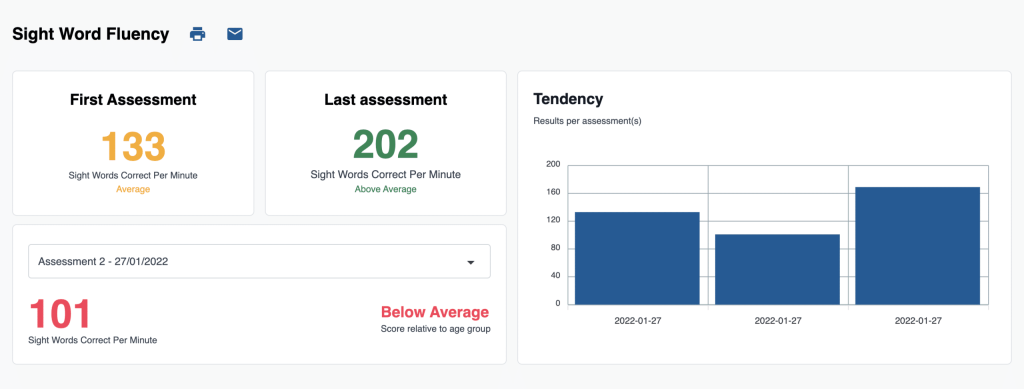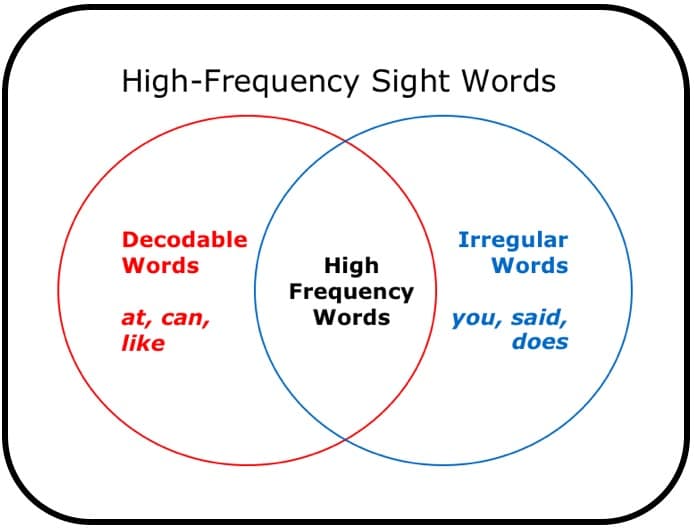Whether you are a teacher or a parent, you’ll have heard of ‘sight words’. Across Australia, teachers send sight words home with primary students to be memorised with the help of Mum or Dad. The hope is that the extra practice will increase the students’ ability to remember and recall them and therefore improve their reading and spelling abilities.
In today’s post, we’ll cover all the information you need to know about sight words!
- What are sight words?
- Why do sight words matter so much?
- How to teach sight words
- 200 free flashcards download
What are sight words?
Technically, everyone has their own ‘bank’ of sight words or words that they can read without effort. Sight words can be read instantly and usually within a 20th of a second!
The term ‘sight words’ is often used interchangeably with high-frequency words, which is actually the term for how often words appear in written language. For clarity though, in this article, we will use the term ‘sight words’ to mean the most frequently occurring words that readers need to access quickly and by sight.
While many schools source their sight words from traditional lists such as Fry (updated in 1980), Dolce (1936), or Oxford list (updated in 2017), Dystech utilises the most common sight words from Google’s Trillion Word Corpus. Google has collected a huge corpus of text containing a total of more than 1 trillion words. It easily computes the frequency of each word and is then in a position to rank the words according to their frequency.
At Dystech we have applied years of research to the development of Dyscover, our online reading measurement platform. Our word reading exercise combines roughly 2-hours of traditional paper-based reading tests into a 5-minute online assessment, drastically reducing the time it takes to assess reading progress for hundreds of schools and literacy clinics. Sight word fluency is measured in each assessment.

Why do sight words matter so much?
Instant recall of sight words is important because it allows students to be faster and more fluent readers, thus having a positive impact on their confidence in reading. Quickly identifying sight words impacts their reading fluency, enjoyment of making sense of a text independently, and self-esteem as learners. It is interesting to note that 50-75% of words written in children’s literature are sight words, so you can see the value in memorising them.
That may sound easy for the majority of students. For them, sight words are not too much of a big deal; however, if they are one of the 30% who learn differently, learning sight words can be more difficult. Whether a student is dyslexic, has ADHD, dysgraphia etc, or is an instructional casualty, they may well struggle with this task unless we find a way to support them.
An important overlap
As you can see below, high-frequency sight words are a mixture of both decodable (or regular) words that follow the set of correspondences between the most basic sounds of English (called phonemes) and the letters that represent them (called graphemes), and irregular words that don’t follow that principle.

The wonderful thing about regular words is that they don’t need to be memorised if a child has been taught the phoneme to grapheme relationship through systematic, synthetic phonics (SSP). The British Dyslexia Association defines SSP as ‘an approach that teaches children to recognise letters (graphemes) and their associated sounds (phonemes). It is also known as alphabetic phonics and involves breaking the word down into the smallest units of sound.’
The video below from the FIVE from FIVE Reading Project, explains systematic, synthetic phonics well.
If you have already embraced structured literacy, take a look at these free decodable books to support your phonics approach. You’re welcome 🙂
If you aren’t one of those lucky people who teach structured literacy, but you are ready to follow the science, CodeRead has many great resources on its website that discuss structured literacy and recommended reading programs.
Why are sight words important?
This is important because only 16% of English words are irregular. This significantly reduces the number of sight words that a child needs to actually memorise on their educational journey because the remaining 84% of words are regular! They follow rules.
Teaching one rule such as the /ck/ rule below, provides students with access to 50+ words that can be decoded and encoded, freeing up their brain space that would otherwise be trying to memorise words individually. So teach the sounds and rules for regular words, and techniques for memorising irregular ones, right?
Good news for those struggling students!
To understand the /ck/ rule further, please watch this great video from Nessy.
How to teach sight words
There is no getting around the fact that when students start school at around 5 years of age, the majority of them won’t know the sounds for every letter, nor the multiple graphemes for each sound.
Until students are confident with the basics, you may decide to teach students to memorise both regular and irregular sight words initially, so they can read and write them independently early on. How and whether you do this will be determined by the pedagogy or program your school follows.
In the article, ‘Spelling irregular words: An evidence-based literacy strategy‘ by Shannon Kelley, she maps out a strategy for memorising sight words and activities that you might find helpful. The learner engages more than one of their senses when taking in new information, including aural, kinaesthetic, visual, and tactile activities, supporting transference into long-term memory.
The outline below is an example strategy and allows students to repeatedly say, spell, write, and read the word they are memorising.
Steps
- Choose one word (eg. through)
- Introduce the word, use it in context, and have the students repeat it back to you
- Explain* what part of the word is irregular and underline that part (through)
- Say the sounds as you write each part (th-r-ough)
- Say “through is spelled t-h-r-o-u-g-h’
- Have the students say that back to you
- Ask the students how to spell ‘through’ as you point to each letter
- Reinforce, saying ‘that’s right, we spell through ‘t-h-r-o-u-g-h-‘
- Students then write the word in the air, saying each letter name, then the whole word at the end
- Students write it on paper three times, saying each letter name, then the whole word at the end
*Only for irregular words otherwise skip this step
As students become more competent with learning regular words through patterns and rules, the above approach can continue with irregular words only.
It is significant to note that ‘…a student’s spelling ability directly relates to reading ability. That’s because the ability to spell a word shows how well the word is stored in a student’s long-term memory. The more words students have in their memory, the more fluent their reading can become. But even strong readers can struggle with spelling. That’s why all students benefit from spelling practice.’ (Kelley)
We hope this article has given you some clarity about sight words and how they can be taught. We’d love to hear about how you teach sight words to your students or children at home as well.
Looking for a quick and easy reading assessment to assess sight word fluency? You can use Dystech completely free, and access all their standardised online assessment. Learn more here
200 flashcards download
These printable sight word flashcard sets help grade school children develop reading fluency and confidence, as they learn to quickly recognise words by sight. The download includes all the 200 most frequent words coming from the Google Trillion words corpus.
For more, here is 10 tools for english reading teachers